Here’s a classic Guitar International interview from Feb 16, 2006.
Roger McGuinn Interview
by Rick Landers
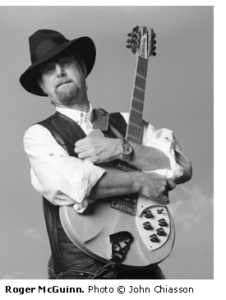 During the mid-60s, the US music scene was overwhelmed with rock groups from England, to the point where the phrase “British invasion” entered the American lexicon. In response, one homegrown U.S. group emerged to fill the airwaves with a new and unique sound that became known as folk rock.
During the mid-60s, the US music scene was overwhelmed with rock groups from England, to the point where the phrase “British invasion” entered the American lexicon. In response, one homegrown U.S. group emerged to fill the airwaves with a new and unique sound that became known as folk rock.
The Byrds.
The Bryds were fronted by Roger McGuinn on vocals and his chimey 12-string Rickenbacker. The group laid down the gauntlet with a string of singles with McGuinn’s signature “jingle jangle” guitar work shining through with strong melodic undercurrents.
Although, Roger was certainly the hub of the group, David Crosby, Gene Clark, Chris Hillman and Michael Clark were equals when their mix of personalities, musical influences and individual talents sparked, igniting hits like “Mr. Tambourine Man,” “Turn, Turn, Turn,” “So You Wanna Be a Rock ‘n Roll Star,” and “Eight Miles High.” All of the songs are enduring classics that conjure up the phantasmagorical subculture of the Haight-Ashbury and Carnaby Street scenes, where the air was filled with flower power, peace, love, music, incense and other sweet smells of the moment.
Late in their career, the Byrds settled into their Sweethearts of the Rodeo album that would inspire the Eagles, the Flying Burrito Brothers and others into yet another style called Country Rock. The group disbanded in 1973 and Roger moved on to a solo career.
By 1978, Roger, Gene Clark and Chris Hillman got back together and signed a six album deal with Capitol Records and released their first LP McGuinn, Clark & Hillman (Capitol Records — 1979). Unfortunately, the group didn’t capture the magic or success of their previous collaboration and eventually moved on. There were more fitful starts and stops and by the 1980s, Roger’s solo career again made sense.
Born James Joseph McGuinn III in Chicago on July 13, 1942, by the time Roger reached his teens, he was inspired by such songs as “Abilene,” “Well, Well, Well,” and “You Can Tell The World” and their co-writer, folk legend Bob Gibson.
A folk singer at heart, McGuinn has maintained the storytelling tradition of that genre in his songs for his entire career. This coupled with his sense of musical composition and other talents have blessed him with not only a long career, but one where the name Roger McGuinn is well respected and recognized around the world.
In 1991, McGuinn, along with the Byrds, was inducted into the Rock n’ Roll Hall of Fame. That same year he released his superb Back From Rio CD that included a cast of luminaries like Elvis Costello, Tom Petty and the Heartbreakers, David Crosby, Chris Hillman, John Jorgensen and Michael Penn.
Always a traditionalist, McGuinn again journeyed back to his roots in 2002 when he released Treasures From the Folk Den with a series of duets that include Pete Seeger, Odetta, Josh White Jr., Joan Baez, and Judy Collins. This highly acclaimed CD was nominated in 2002 for a Grammy in the Best Traditional Folk Album category.
As an early adopter of new technologies, Roger has gained expertise in the area of home recording and in 2004 issued the DVD Roger McGuinn’s Guide to Home Recording on a Computer. The DVD is an instructional course that takes viewers through editing, fading, and mixing a recording as he lays down songs track by track. At one point, he makes a mistake, then takes the time to show his “students” how to fix it.
McGuinn has two other DVDs available, one that gives instruction on twelve-string guitar (The 12-String Guitar of Roger McGuinn) and another on how to play folk guitar (Roger McGuinn’s Basic Folk Guitar).
This year McGuinn released The Folk Den Project 1995 — 2005, a four CD edition that compiles 100 of his favorite folk tunes. The Folk Den effort started out as a way for Roger to help preserve the folk music tradition of handing down music to the next generation and this new set pulls together the best of the best doing just that.
Modern Guitars (Guitar International) met with Roger before he went on stage at the Melodee Music auditorium in Sterling, Virginia, where he sang and talked to the audience about his career, his interests in music, and some of the guitar techniques he’s employed to get that signature McGuinn sound.
******
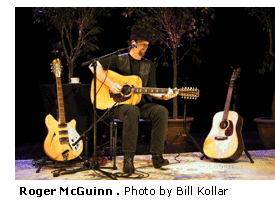 Many people claim that you first discovered the 12-string guitar after seeing George Harrison play his Rickenbacker?
Many people claim that you first discovered the 12-string guitar after seeing George Harrison play his Rickenbacker?
Roger McGuinn: The first 12-string guitar I bought was probably around 1957. I was influenced by Leadbelly, Pete Seeger, Bob Gibson and a lot of the folk singers. In the late 50s, I was in Chicago and went to the Old Town School of Folk Music. That’s where I learned about Leadbelly. Leadbelly’s guitar is in the Rock n’ Roll Hall of Fame.
I went to the south side of Chicago and got what I thought was a Stella, but it had a spruce top. It was a nice sounding guitar. I got a 12-string very early on and it wasn’t my main instrument, but something that was certainly part of my repertoire.
On your Limited Edition CD, you pay tribute to George. Was he a friend?
RM: Yes, we were friends. He was very reserved. A really sweet guy, he loved his music, loved his family. Not much to say. We went to his house in Hyde Park and he was kind enough to show us around. He let me play his Rickenbacker that he played on A Hard Day’s Night. Showed us around his studio and we all went out to dinner. Early on the Byrds went to see A Hard Day’s Night, a kind of reconnaissance trip. And we took notes on what the Beatles were playing and bought instruments like they had. We got a Gretsch Country Gentleman and the Rick.
You recorded “Turn, Turn, Turn” before forming the Byrds?
RM: I was sort of a sideman. I was a studio musician in New York. I did quite a few sessions with Elecktra Records. And around 1963, Judy Collins was doing a session at the time. So, Jac Holzman (Founder, Elektra Records) had me recording on a Judy Collins album and I started playing on that track. I ended up coming up with a lot of ideas and by the end of it she gave me a nice, very generous, credit as Musical Director.
What songwriters have influenced you or you’ve enjoyed over the years?
RM: Songwriters, hmm. Let’s see, I loved Lennon and McCartney, Pete Seeger, love his work. Bob Dylan, loved his songwriting. You mentioned Fred Neil earlier, I like his work too. People like Leonard Cohen and Joni Mitchell.
How did the instantly recognizable Byrds sound come about?
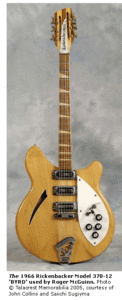 RM: The sound actually was formed in New York before I flew out to California. Well, not the 12-string Rickenbacker part, but the part about mixing folk and rock.
RM: The sound actually was formed in New York before I flew out to California. Well, not the 12-string Rickenbacker part, but the part about mixing folk and rock.
I was working as a songwriter in Bobby Darin’s publishing company in the Brill Building. My job was to listen to the radio and write songs like ones that came over on the radio.
The Beatles came out about that time and I got really jazzed by the Beatles. I loved what they were doing and they were doing a lot of passing chords. Like instead of just going like G, C, D, they’d go G, Bm, Em, C, Am, to D. So, the minor and passing chords I liked and, I thought these are really folk music chord changes. I kind of got it from what they were doing, I guess because they’d been a skiffle band.
I imagined that they were more folk oriented than they really were. I thought they were probably more a folk band that could play bluegrass banjo and mandolin, but they chose to do pop music because it was more commercial.
Turned out not to be the case. But in my imagination this whole thing developed and I started mixing up old folk songs with the Beatles beat and taking them down to Greenwich Village and playing them for the people there. To the point where a guy put out a sign outside that said, “Beatle Imitations.” I was kind of put off by that.
What pulled you to California?
RM: An opportunity came up right after that to fly out to California to play in Doug Weston’s Troubadour. I opened for Roger Miller and Hoyt Axton and took that repertoire out there, the folk music with the Beatles’ beat and the folk purists had kind of a mixed reaction. But that’s not all that were there.
One guy in the audience got it.
Gene Clark came up after the show and said, “I like what you’re doing, let’s write some songs together.” We had the same vision. So that was the nucleus of the Byrds. But the idea of mixing the folk and the rock act came ready-made from New York.
I always got a kick out of it when they called it the California Sound because it really came out of Liverpool and Greenwich Village. [Smiles]
Did Bob Dylan ever say anything about your renditions of his music?
RM: Yeah, in fact he was at our rehearsal hall when we were working up the song “Mr. Tambourine Man.” Not only that song, but we did quite a few of his other songs.
And I remember playing, I think it was “All I Really Want to Do” and he asked, “What was that?” I told him it was one of his songs. And he said, “Ah ha!” He didn’t recognize it. Bobby Neuwirth was there and said, “You can dance to it, that’s pretty cool!”
And they were very supportive of what we were doing with Bob’s music. So, we recorded “Mr. Tamborine Man,” and Albert Grossman tried to stop it. Bob was behind it, but his manager wasn’t. But, it had already gained enough momentum that Columbia couldn’t stop it.
What guitars are on your favorites list?
RM: Well, I guess that early 12 string. The first Martin I bought. I bought it around 1957 with money I earned as a janitor assistant. I bought brand new. I still have that. A five string banjo, a Vega long neck. I traded that for my first Rickenbacker and the first Rick was one of my favorite guitars.
Then, I guess, the Country Gentleman. I liked that a lot. And some of my other Martins. I have a D-12-35. I bought it new in 1967 or 68. I have from around the same time period a Martin D-12-45 which is really pretty. They didn’t make that many of them. I don’t really collect guitars. I like my Rick Signature 12-string model. I like that a lot. I like the Martin Signature 12-sting that Martin made in 1999.
What about the newest Roger McGuinn 7-string by Martin Guitar?
RM: Of course, the HD-7 I’m happy how that came out.
I went to Dick Boak (Director of Artist Relations & Publicity, Martin Guitar Company) and told him we we’re planning a European tour and Air France had broken my D-12-42RM. Dick was able to repair it, but it still had scars and cracks. I didn’t want that to happen again.
I wanted a guitar and thought it would be great if I could get one that had that jingle jangle thing on the G string and be able to bend like a six-string. So, I told Dick about my vision for a composite and he worked out a little design at the tail piece.
We talked about where to put the four strings as opposed to the, you know, three below and four on top. And I wanted D-45 inlays on it and we kept the herringbone. It’s basically a D-28. It’s Indian Rosewood. Brazilian would have kicked the price up. But this one has quite a punch to it! And this is number 7, HD-7. Dick’s idea. So those are the guitars in my life!
Please, tell us about your teaching DVDs.
RM: Okay, Happy Trail approached me I guess about 5 years ago to do one. The first one was a 12-string Rickenbacker oriented DVD where I actually show you how to adjust the tension rods in the neck by taking the plate off and how to change strings. Also, how to change the battery because it has a built in compressor circuit.
The sound we got with the Byrds uses two compressors run into each other. I had the compressor built in to the guitar and it sounds very much like it.
So, I do that and I play a couple of songs and demonstrate how it works. That’s basically the first one.
The second one is a more simplified folky one. I play a couple basic folks songs and break them down. I did that on a six string. I can’t recall all the songs on it. There’s some finger picking on it. Somebody actually complained on Amazon.com saying “This is NOT basic guitar! He’s finger picking and flat picking, so many beats per minute!” [Laughs] It does have that, but it also has some slowed down parts, so you can learn them.
And the third one, probably my favorite, is the DVD on how to record on a computer.
RM: I am! That’s my favorite subject because it really levels the playing field for artists these days. You don’t have to sell out to the record company. You don’t have to get a five hundred thousand dollars, or whatever, and pay them back for the rest of your life to record a record.
Now, you can just get a laptop, get some software, put a microphone on it and make a record. You have to know how to do it. It does help if you’ve had 35 or 40 years of experience in the studio. But, it still levels the playing field so artists can record their own stuff.
Your CDs are recorded at home?
RM: Yeah, that’s how we did my latest Limited Edition CD. One track was recorded in a studio in Nashville and the other twelve were recorded on a laptop, a Dell laptop. And that’s why I did it. Specifically for that purpose. To prove a point. To show that you could record an entire CD on a laptop.
When writing songs do you first start with a chord progression?
RM: Yes, basically, like you said, I’ll work out a chord pattern and work out the lyrics over that. Once in a while and really the exception, will be when I have an idea, then I’ll write a poem first and then write a tune to the poem.
Have some new chord patterns sitting around waiting for poems?
FM: Yeah, I do have a couple sitting around. Once I’ve written a song, I sometimes refine them. There’s one on the recording DVD, a poem from Ireland, “May the Road Rise to Meet You.” I think I had just put some on some new strings and I went in the powder room in my house and wondered if anyone had ever made up a tune to go with it. I had to revise the words a bit to make them rhyme.
So, I came up with a tune for that and kind of reworked the words so it would rhyme. And then I showed it to my wife, Carmella, when she came home and the two of us wrote down some verses. She’s been helping me since 1978. It was the exception to the rule though to come up with the chords and make up the melody.
Do you think the folk tradition of passing down songs from person to person has died?
RM: No, I don’t think so. I think with the advent of the Internet it’s still a one-on-one experience. When you’re sitting in front of a computer like my folk tune project, you can listen to it in MP3 and see the lyrics and the chords and story about the song. You can listen to it and learn it right off the DVD. It’s still a one-on-one experience for the person who’s watching it. Because you can reach so many more people now, it’s the oral tradition amplified.
Do you prefer smaller venues?
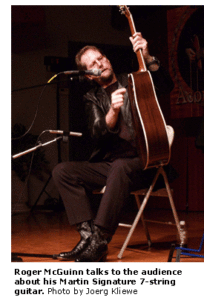 RM: I love the intimate surrounding. Where it gets to be less enjoyable is when the audience claps and there’s a time delay. So, it has to be a certain number of feet that the sound can travel and still be in the same number of milliseconds, so it will still be acceptable in that meter.
RM: I love the intimate surrounding. Where it gets to be less enjoyable is when the audience claps and there’s a time delay. So, it has to be a certain number of feet that the sound can travel and still be in the same number of milliseconds, so it will still be acceptable in that meter.
Otherwise, it gets too far away and when they clap there’s a time delay. If it’s like a thousand feet away, then it’s off. It’s off the beat. I like it to stay within the same sonic frame.
What else beside music occupies your time?
RM: Well I love music and it’s what I do for a living. We love traveling. I get to do concerts and travel with my wife, like Charles Kuralt. I have his book and it’s fun reading about his life. And I’m into electronics and computers.
While on stage, how do you weave the old tunes with your newer music?
RM: I do the songs that people want to hear usually at the end of the set. I start out with maybe one, maybe two songs from solos CDs, folks tunes. And then come up with the end of the set with from solo CD and then “Mr. Tambourine Man”, “Turn, Turn, Turn” and “Eight miles High.”
Let’s roll through some quick questions of your favorite things.
Book? The Bible.
Beverage? Water
Song? “Turn, Turn, Turn”
Album? If we’re talking about mine, then it’s the Limited Edition. Others? I like Pet Sounds and Meet the Beatles. My overall favorite is probably a Beatles album. Not Sergeant Peppers, maybe Revolver.
Car? I love my Ford van. I love it! Everything you need, a little house!
Guitars? I like my Martin acoustics and Rickenbacker electrics. Various models.
Quote? “To everything, turn, turn, turn. There is a season, turn, turn, turn. And a time for every purpose under heaven.”
Guitarist? Andre Segovia. Clapton.
Do you have a special concert moment that you cherish?
RM: When I was at a festival and I started singing “The Ballad of Easy Rider” and Odetta joined me on stage. It choked me up. She liked the song and she’d recorded it. It was a real honor.
Do you have any sage advice for musicians who have just had their first hit?
RM: Well, if they already have a hit song, it’s too late to get your deal together. Try to get all of your publishing in your name from now on, so it’s yours. And watch out for your manager. You can’t trust your manager or business manager to keep on eye on your best interests. You want to trust them, but it’s a luxury you can’t afford.
Tell us about your latest Limited Edition CD.
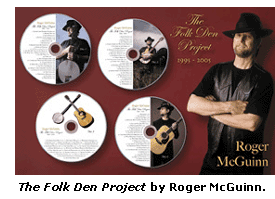 RM: The latest the one was a response to fans, people on the Internet, e-mails asking me to record another Rickenbacker electric album. My previous two had been acoustic, Treasures from the Photan and Life on Mars. So, I dusted off the old Rickenbacker and did the jingle jangle album. We started it off with the George Harrison tribute “If I Needed Someone,” which was a song we recorded in Nashville.
RM: The latest the one was a response to fans, people on the Internet, e-mails asking me to record another Rickenbacker electric album. My previous two had been acoustic, Treasures from the Photan and Life on Mars. So, I dusted off the old Rickenbacker and did the jingle jangle album. We started it off with the George Harrison tribute “If I Needed Someone,” which was a song we recorded in Nashville.
This is a funny story. When we got to Nashville, I expected to use a 24-track and a board. When we got there we found hundreds of thousands of dollars worth of equipment sitting in a corner and they’re recording with a mouse! And this little computer! I said, “Wait a minute! I can do this at home!”
We recorded the rest at home on a laptop and really just to prove a point. We recorded it in the family room. I did hired musicians and they’d come in and we paid them. It was a real recording session. But it just happened that instead of using the computer in the studio, we recorded it in our house. And studio time was free. It was a much more relaxed atmosphere.
Just how do you get that jingle jangle sound?
RM: The sound is a combination of several things. It’s compressed. I have to credit Ray Gerhard. He’s an engineer at Columbia Records. He came up with the idea because without compression the Rick kind of falls off. It doesn’t sustain a long time. And he compressed that into another, a serial compression.
The other thing is the arpeggio style I play comes more from a 5-string banjo. And then a lot of the folky stuff, like the Travis picking behind the lead break. Underneath it I’m playing (Plays), rolling. So, I’m overdubbing the lead break and doing the rolling underneath it.
I guess that’s the sound. Banjo picking, compression and some other little folk techniques I picked up along the way.
Do you foresee a Byrds reunion concert?
RM: I don’t think so. I’d like to leave it as a good memory. It’s hard to reheat a souffle as Paul (McCartney) said one time. We really couldn’t live up to it. It would be a sentimental thing, people would go, “Nice to see them together!”, but would it be better? I don’t know.